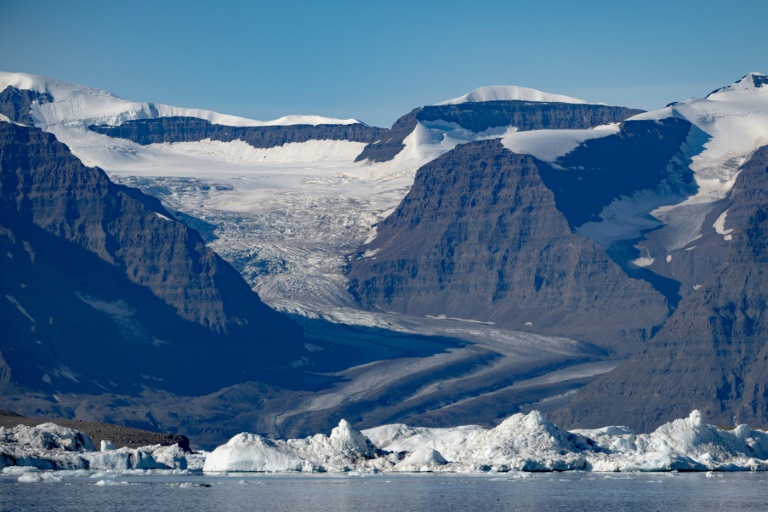Science
Greenland’s Glaciers Experience Doubling Retreat Rate Since 2000

A comprehensive study reveals that Greenland’s peripheral glaciers have experienced a remarkable acceleration in retreat over the past two decades. Conducted by researchers from Northwestern University and the University of Copenhagen, the research spans from 1890 to 2022, marking a significant shift in understanding how climate change has impacted these vital ice formations.
Using a combination of satellite imagery and a unique collection of historical aerial photographs, the study provides the most complete picture of Greenland’s outlying glaciers to date. The findings indicate that the rate of glacial retreat in the 21st century has doubled compared to the previous century. This alarming trend highlights the urgent need for global efforts to mitigate climate change impacts.
Accelerated Retreat Rates Documented
The researchers documented changes in over 1,000 glaciers along Greenland’s coastline, which is distinct from the massive central ice sheet covering roughly 80% of the country. While glaciers in Greenland have been retreating for the past century, the pace of this retreat has accelerated sharply since the year 2000. According to the study, the rate of retreat is now twice as fast as it was during the 20th century.
The study emphasizes that climate change is a driving factor behind this rapid retreat, with glaciers across Greenland responding quickly to rising temperatures. Despite the varied climates and topographical features of the region, the findings remain consistent even among the northernmost glaciers.
Methodology and Historical Context
Prior to the advent of Earth-observing satellites in the 1970s, researchers lacked a comprehensive understanding of how temperature variations influenced Greenland’s glaciers. The breakthrough came about 15 years ago with the rediscovery of aerial photographs taken from the 1930s, now preserved in the Danish National Archives. These images provided a critical baseline for researchers to begin mapping the historical changes in glacier extents.
By digitizing thousands of paper photographs and employing geo-referencing techniques, the research team was able to accurately position the images on modern maps. They also identified terminal moraines—sediment deposits left by glaciers—to trace the historical lengths of the glaciers before aerial surveys began.
Recent analysis shows that glaciers in southern Greenland have lost, on average, 18% of their lengths in the past 20 years. In contrast, glaciers in other regions have seen length reductions ranging from 5% to 10%. This alarming trend underscores the need for increased understanding of how melting glaciers will contribute to rising sea levels and affect freshwater supplies.
The findings of this pivotal study are published in the journal Nature Climate Change, titled “Greenland-wide accelerated retreat of peripheral glaciers in the twenty-first century.” The results serve as a stark reminder of the ongoing impacts of climate change and the necessity for urgent action to address global warming. Understanding these changes is crucial for informing future environmental policies and protecting fragile ecosystems.
-

 Education4 months ago
Education4 months agoBrandon University’s Failed $5 Million Project Sparks Oversight Review
-

 Science5 months ago
Science5 months agoMicrosoft Confirms U.S. Law Overrules Canadian Data Sovereignty
-

 Lifestyle4 months ago
Lifestyle4 months agoWinnipeg Celebrates Culinary Creativity During Le Burger Week 2025
-

 Health5 months ago
Health5 months agoMontreal’s Groupe Marcelle Leads Canadian Cosmetic Industry Growth
-

 Science5 months ago
Science5 months agoTech Innovator Amandipp Singh Transforms Hiring for Disabled
-

 Technology5 months ago
Technology5 months agoDragon Ball: Sparking! Zero Launching on Switch and Switch 2 This November
-

 Education5 months ago
Education5 months agoNew SĆIȺNEW̱ SṮEȽIṮḴEȽ Elementary Opens in Langford for 2025/2026 Year
-

 Education5 months ago
Education5 months agoRed River College Launches New Programs to Address Industry Needs
-

 Business4 months ago
Business4 months agoRocket Lab Reports Strong Q2 2025 Revenue Growth and Future Plans
-

 Technology5 months ago
Technology5 months agoGoogle Pixel 10 Pro Fold Specs Unveiled Ahead of Launch
-

 Top Stories4 weeks ago
Top Stories4 weeks agoCanadiens Eye Elias Pettersson: What It Would Cost to Acquire Him
-

 Technology3 months ago
Technology3 months agoDiscord Faces Serious Security Breach Affecting Millions
-

 Education5 months ago
Education5 months agoAlberta Teachers’ Strike: Potential Impacts on Students and Families
-

 Business1 month ago
Business1 month agoEngineAI Unveils T800 Humanoid Robot, Setting New Industry Standards
-

 Business5 months ago
Business5 months agoBNA Brewing to Open New Bowling Alley in Downtown Penticton
-

 Science5 months ago
Science5 months agoChina’s Wukong Spacesuit Sets New Standard for AI in Space
-

 Lifestyle3 months ago
Lifestyle3 months agoCanadian Author Secures Funding to Write Book Without Financial Strain
-

 Business5 months ago
Business5 months agoNew Estimates Reveal ChatGPT-5 Energy Use Could Soar
-

 Business3 months ago
Business3 months agoHydro-Québec Espionage Trial Exposes Internal Oversight Failures
-

 Business5 months ago
Business5 months agoDawson City Residents Rally Around Buy Canadian Movement
-

 Technology5 months ago
Technology5 months agoFuture Entertainment Launches DDoD with Gameplay Trailer Showcase
-

 Top Stories4 months ago
Top Stories4 months agoBlue Jays Shift José Berríos to Bullpen Ahead of Playoffs
-

 Top Stories3 months ago
Top Stories3 months agoPatrik Laine Struggles to Make Impact for Canadiens Early Season
-

 Technology5 months ago
Technology5 months agoWorld of Warcraft Players Buzz Over 19-Quest Bee Challenge









